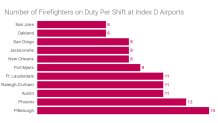Fire officials have increased the number of firefighters and trucks on duty at San Jose Mineta International Airport five months after an NBC Bay Area investigation found the airport had fewer firefighters on duty per shift than most other airports of comparable size.
But critics say the additional resources are still not enough for an airport that’s recently grown considerably in size and air traffic. And they say the lack of resources on site at SJC puts passengers’ safety at risk in the event of a major airplane crash like the accident involving Asiana flight 214 in San Francisco.
The San Jose City Council approved more money for the airport to upgrade its firefighting capability in October because of more international flights and larger airplanes landing at SJC. Because of that increase in traffic and size of airplanes using SJC the FAA upgraded the airport from an Index ‘C’ to and Index ‘D’ Under FAA rules that change in classification required the airport to increase fire resources.
In May, when SJC was still an Index ‘C’ airport, NBC Bay Area’s Investigative Unit found the airport had two aircraft rescue and firefighting (ARFF) trucks and only four firefighters working on any given shift. Although the staffing levels met FAA minimum safety standards, experts called that staffing number a safety hazard. The FAA does set a minimum standard for the number of trucks based on an airport’s size, but it doesn’t set minimum standards when it comes to staffing airport fire departments other than to require airports to provide enough people to man Aircraft Rescue and Fire Fighting or ‘ARFF’ trucks.
As a result of the airport’s new Index ‘D’ classification, SJC added an additional ARFF truck and two additional firefighters per shift, leaving 6 firefighters on duty at any given time.
“The new regulations for ‘D’ require us to have three ARFF vehicles and the proper amount of staff to operate those vehicles,” said SJC Assistant Director of Aviation John Aitken.
The San Jose Fire Department said they’re pleased with the additional resources, which should improve their response to a runway disaster.
Local
“I think the ability for our personnel to respond with three vehicles gives us a chance to cover more exits, put out more fires, effect more rescues, absolutely,” said Deputy Chief of Operations Robert Sapien.
However, some experts say six firefighters aren’t enough to handle a major runway emergency at a major airport such as SJC. Those experts include John Carr, a former San Jose firefighter who helped write the book on aircraft firefighting. Carr and colleague Les Omans served as captains with San Jose’s fire department back in the 1970’s and served at the airport. After retiring, both men created ARFF training manuals, procedures and exercises now used by airports around the United States and around the world.
In SJC’s case, Carr said that with three firefighters driving the ARFF trucks, and one officer directing the response, there are only two firefighters left to evacuate the crashed airplane.
Because larger airplanes are using SJC more frequently, Carr says the issue of safety has become even more paramount. For example, SJC now regularly has several large airplanes landing and taking off every day, such as the 787 Dreamliner, which carries up to 250 people. It’s an aircraft that has 8 different exit doors and escape slides.
Even with the extra personnel on duty at SJC, it leaves just two people to man those eight emergency exit slides at SJC.
John Carr says that simply isn’t enough.
“In my honest opinion, absolutely not,” said Carr. “I mean how does two people get even close to managing eight exits on an airplane?”
“There are just not enough people to do that many and those kind of major aircraft,” Carr said. “And that’s really the bottom line.”
The Investigative Unit compared SJC’s staffing levels to 10 other Index ‘D’ airports and found only Oakland has as few firefighters on duty per shift. The others had between two and nine additional firefighters.

In response to those concerns, airport management said the fire department would arrive quickly with additional resources from outside stations to assist airport fire crews.
“In our discussions with San Jose fire, they are very comfortable with the fact that they can be here expeditiously with the additional staff and rigs to support the airport,” Aitken said.
According to an email memo from San Jose fire officials, the average response time of backup vehicles to the airport is between eight and eleven minutes. When Asiana Flight 214 crashed at SFO, there were 23 firefighters on duty at SFO and they had the entire plane evacuated within 10 minutes, according to NTSB reports. The NTSB credited the fast response with saving lives.
Carr said the six firefighters on duty at SJC couldn’t respond nearly as quickly to a similar emergency.
“It’s all nice on paper, but when you don’t have the bodies on the rigs initially, it’s hard to recreate them,” he said.
Emails obtained by NBC Bay Area between Delta Airlines and officials at SJC show the airline also had concerns with firefighter staffing levels. According to the emails dating back to February of last year, Delta insisted on higher minimum staffing at SJC for several chartered 747 aircraft and even paid San Jose to staff more fire fighters before they would land the aircraft there.
“On two occasions, Delta has requested an additional fire engine at San Jose International Airport for one-time charter flights on widebody 747-400 aircraft,” Delta said in a statement provided to NBC Bay Area. “Safety and security is always Delta’s top priority.”
Carr said SJC is not the only airport without sufficient firefighting resources and would like to see the FAA require more personnel at every airport. In a statement, the FAA said the requirements are adequate.
“The FAA is satisfied that San Jose International Airport meets the current regulatory requirements for Aircraft Rescue and Fire Fighting equipment and personnel. Safety is always our top priority, and these regulatory requirements have proven to be effective nationwide in protecting the flying public.”



